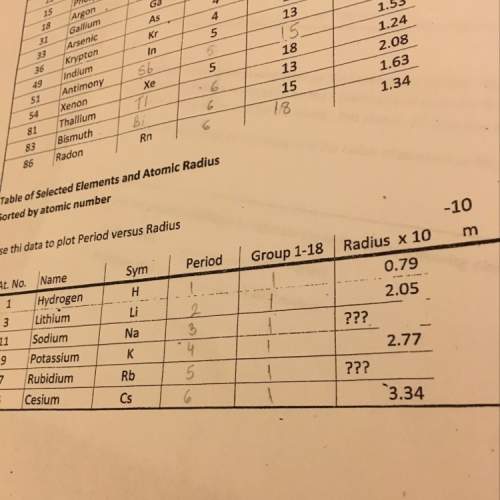
Chemistry, 26.08.2021 02:00 SketchWasTaken
Sasha did an experiment to study the solubility of two substances. She poured 100 mL of water at 20 °C into each of two beakers labeled A and B. She put 50 g of Substance A in the beaker labeled A and 50 g of Substance B in the beaker labeled B. The solution in both beakers was stirred for 1 minute. The amount of substance left undissolved in the beakers was weighed. The experiment was repeated for different temperatures of water and the observations were recorded as shown.
Experimental Observations
Substance Mass of Undissolved Substance at Different Temperatures (gram)
20 °C 40 °C 60 °C 80 °C
A 12 11 9 8
B 45 40 34 31
Part 1: Which substance has a higher solubility?
Part 2: Explain your answer for Part 1.

Answers: 2


Other questions on the subject: Chemistry

Chemistry, 22.06.2019 00:30, bryneosburn
Lem 2 the data below are for the system ethyl propyl ether (1)-chloroform (2) at 0.5 bar. use the data to answer the following questions (all questions refer to p d 0: 5 bar). a) what are the boiling points of the pure components at 0.5 bar? b) a mixture with the overall composition z1 d 0: 1 is brought to 47.6ä±c, 0.5 bar. what is the phase? c) 100 mole of a mixture with z1 d 0: 1 (state a) is mixed with 22 mole of pure ethyl propyl ether vapor (state b). the mixing takes place at 47.6 ä±c, 0.5. bar. what is the phase of the resulting mixture (state c)? if the state is a v/l mixture report the number of moles and mole fractions in each phase. d) plot the txy graph and show states a, b and c. the graph must be done by computer and should be properly annotated. ethyl propyl ether (1) - chloroform (2) at 0.5 bar t ( ä±c) x1 y1 t ( ä±c) x1 y1 42.9 0.000 0.000 49.0 0.470 0.455 43.0 0.020 0.010 49.1 0.520 0.520 43.9 0.065 0.029 48.9 0.567 0.592 45.4 0.156 0.089 48.3 0.652 0.720 46.4 0.215 0.142 47.6 0.745 0.815 47.6 0.296 0.223 46.7 0.822 0.872 48.3 0.362 0.302 45.7 0.907 0.937 48.7 0.410 0.375 44.6 1.000
Answers: 3

Chemistry, 22.06.2019 22:30, StupidFatChipmunk
What must be in balance for temperatures to remain constant?
Answers: 1

You know the right answer?
Sasha did an experiment to study the solubility of two substances. She poured 100 mL of water at 20...
Questions in other subjects:

Mathematics, 20.08.2019 21:10

Biology, 20.08.2019 21:10


English, 20.08.2019 21:10

Social Studies, 20.08.2019 21:10

English, 20.08.2019 21:10

Social Studies, 20.08.2019 21:10







